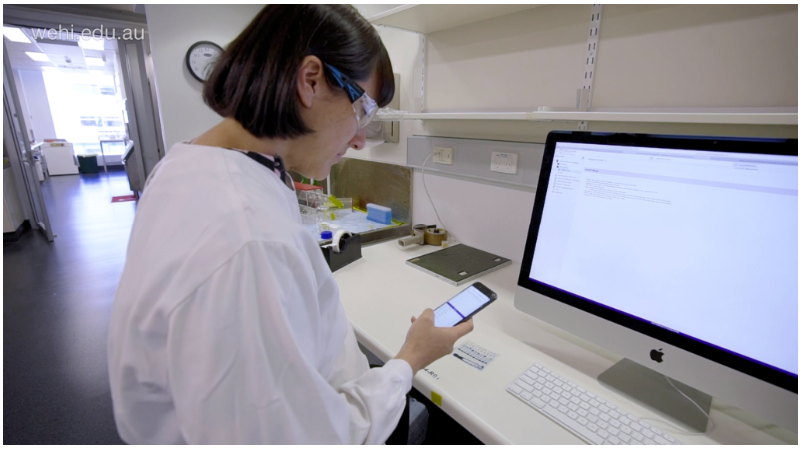Finding a digital solution that makes an everyday task easier, is like buying an eighteen speed bicycle. It’s a huge upgrade from the three speed that simply got you from A to B. But to go further, faster you have to learn how to leverage the high-tech specs you paid for. This’ll involve a bit of grunt work and maybe a few crashes.
In the world of scientific research, a three speed just doesn’t cut it anymore. While paper lab notebooks are familiar and get the job done, they’re not secure or compliant. They’re easily lost and can’t hold a GB of data, let alone a TB. Paper notebooks can’t keep up with the digital pace of research in 2020.
So why are so many institutions still using paper? Because changing behavior is hard.
When a digital solution is introduced, the three to eighteen speed learning curve must take place on all institutional levels. Whatever department is tasked with rollout often has to dedicate all of the elbow grease they can muster to drive uptake. Reactions vary.
The growing pains of change that radiate from upper management to the researcher’s bench and back again, can be a deterrent from implementing a solution at all. With a strategic approach to the digital shift and a focus on end user buy-in, however, success is more than achievable.
The Research Support Group at the Walter and Eliza Hall Institute (WEHI) works to do just that, support researchers. When they set out to implement a digital solution to the paper notebook problem, their aim was to simply serve WEHI researchers better.
 The Walter and Eliza Hall Institute in Melbourne, AUS. Photo courtesy of the Walter and Eliza Hall Institute
The Walter and Eliza Hall Institute in Melbourne, AUS. Photo courtesy of the Walter and Eliza Hall InstituteThe group quickly learned that several WEHI labs had already tried to implement digital notebooks. Demand for a solution was clearly present. However, as Project Manager Sheila Dias put it, “Appetite alone isn’t enough to drive change”.
Sheila used to do bench research herself. She understands the challenges researchers face, and the ‘language’ that they speak. She could see when and why researchers might embrace a digital notebook and where they might hesitate.
Sheila and the Research Support Group wanted to make everyone’s journey to digital as seamless as possible. To do this, they knew their approach would need to be tailored and inclusive without placing unrealistic demands on their time and energy. Leveraging end user buy-in rather than relying on elbow grease has been key to their success.
The task? Transition all 800 WEHI researchers from paper lab notebooks to LabArchives digital notebooks. The goal? On-board 100% of WEHI researchers and achieve 60% active usage in just one year. Lofty.
By month seven, 60% of WEHI researchers were actively using LabArchives and 80% had been successfully on-boarded. By the end of the year, 80% were conducting their day to day research in LabArchives. The achievements of this roll out plan are impressive. Especially so when you consider that the Research Support Group didn’t have unlimited resources to devote to implementation. Most institutions don’t.
Before the group launched LabArchives, they drew up a strategic plan for fast and far reaching uptake that wouldn’t demand all of their resources. They turned to LabArchives implementation experts for support. As Sheila said, “We’re a big institution, we wanted to do this right and support our researchers the best that we could. LabArchives understood what we wanted and helped us get there, some of the ideas we ended up using in our rollout plan came from other organizations LabArchives had worked with”.
WEHI researchers fell all over the spectrum in terms of willingness to change how they documented their work. Many took to LabArchives straight away. Others approached it with a ‘try it out’ attitude. A few were more hesitant.
After taking the institute’s pulse, Sheila and her group set out to secure end user buy-in on the largest scale possible. By taking their time to genuinely earn user buy-in, the group has laid the groundwork for efficient and sustained success. This step, as it turns out, was the most important step of the entire implementation process.
The group segmented WEHI labs into four ‘waves’ of 20. Each ‘wave’ received a seminar focused on LabArchives workflows, features, functions and overall ease of use. Every seminar was an opportunity for researchers to identify aspects of LabArchives that might actually matter to/benefit them. From there, researchers were often ready to buy-in on their own terms. As Sheila and her teammates noted, “showing rather than telling”, worked perfectly.
Labs that were then ready to give LabArchives a go, made themselves known. The Research Support group moved quickly to on-board them. They conducted a one hour workshop with each lab to help them setup the platform for their purposes. This hour was an hour well spent too – the workshops removed the guess work for labs and helped them get going quickly. The response was hugely positive.
Following the workshop phase, new labs began trickling into weekly open door training sessions as word of successful usage spread.
 Dr Margs Brennan uses LabArchives to document her work. Photo courtesy of the Walter and Eliza Hall Institute
Dr Margs Brennan uses LabArchives to document her work. Photo courtesy of the Walter and Eliza Hall InstituteWith about 200 researchers coming and going from the institute each year, ongoing uptake is crucial to the project’s sustained success. Because the Research Support Group took time to secure user buy-in from the start, the cycle repeats itself on demand. WEHI researchers who remain help bring new members into the digital community. Uptake has gone so well that WEHI plans to discontinue paper notebooks all together by 2020. It’s a win for the institute, researchers and the environment.
Since the start of the WEHI rollout plan, feedback has been mostly positive. Many researchers appreciate how the platform allows for real-time conversation around raw data. Some labs even use LabArchives to present findings during meetings which saves them time. Having all data recorded in one secure place has led to more comprehensive work and collaboration. Even dry lab researchers, who often have highly specific workflows, are enthusiastic about the new platform.
The Research Support Group at WEHI has taken nearly 800 researchers from the three speed status quo to a place where digital documentation is the norm. WEHI now has a consistent and secure data management solution that provides value for all parties and will continue to do so. As WEHI has seen, an eighteen speed landscape is best and most quickly built when opportunities for end user buy-in pop up early and often.
















